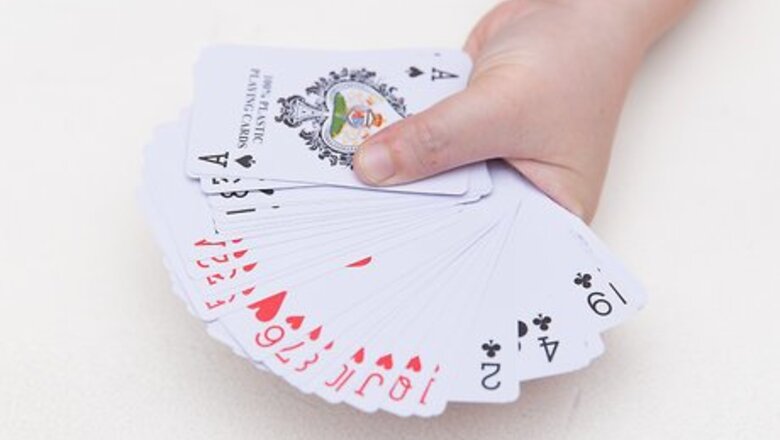
views
Preparing to Play
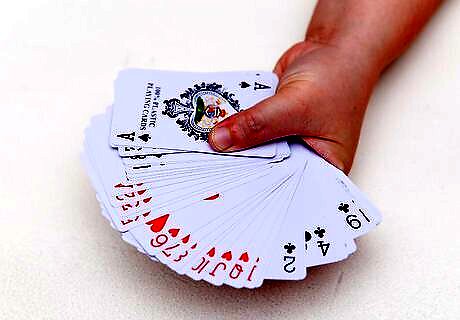
Grab a deck of playing cards. Part of big two’s popularity is that it is one of many games that can be played using a traditional 4-suit, 54-card (including jokers) deck. You probably already have one in your home that you’ve used in the past; grab it to get started. If you need to buy one, the size/design won’t make any difference, just be sure it has 4 full suits of clubs, diamonds, spades, and hearts.
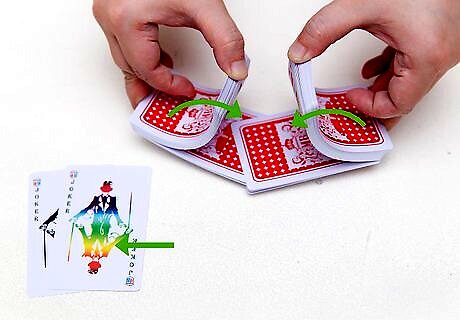
Shuffle the deck.. Like poker, big two is a game which draws its chance from the random-ness of deck shuffling and dealing. You’ll want to be very thorough in shuffling (first remove the two jokers), especially if your deck of cards is a recent purchase. Once you’re done shuffling, “cut” the deck (remove any number of cards from the top in a single pile) and place the cut pile to the side. Once this is complete, pick one player amongst yourselves to be the dealer. The dealer receives no special advantages in gameplay, so it is more or less an arbitrary choice.
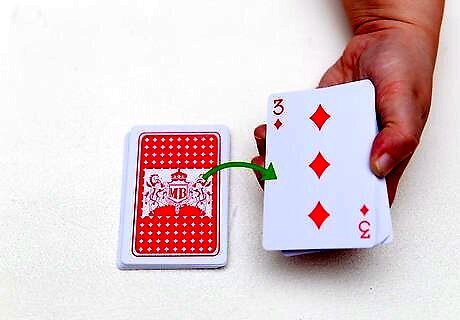
Decide who is dealt to first. Before dealing out cards, you’ll need to decide to whom to deal to first. In big two this is determined by the cut pile just made. Look at the bottom card of the cut pile for its rank, from ace to king (then replace the pile on top of the deck). Going counterclockwise and starting with ace as 1, count players until you reach the rank of the card at the bottom of the cut pile. This player will begin the game. Provided you’re playing with four people, certain ranks match with players in the counterclockwise order, such that you don’t need to count it out. If the card was an ace, a five, or a nine, the dealer will be dealt to first. If the card was a two, a six, or a ten, the player to the right of the dealer will be dealt to first. If the card was a three, a seven, or a jack, the player sitting opposite the dealer will be dealt to first. If the card was a four, an eight, or a queen, the player to the left of the dealer will be dealt to first.
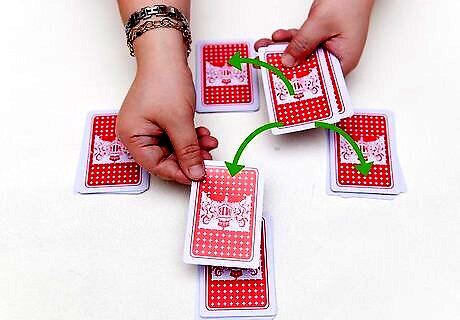
Deal the cards. Starting with the player just determined, have the dealer deal thirteen cards (counterclockwise), one at a time, to every player. These thirteen cards will comprise the player’s starting hand, with the goal being to play every card you’ve been dealt. Whoever is dealt the three of diamonds begins the game as first player. If you’re playing with three players, deal each player seventeen cards and place the last card, face up, on the table. The player with the three of diamonds takes this card into their hand, unless the card itself is the three of diamonds in which case the player with the three of spades take the card.
Playing Big Two

Begin the game by playing the three of diamonds. In the rules of big two, the three of diamonds is the lowest ranked card, so it must be placed first either by itself or in some combination. The rules of big two revolve around the game’s own ranking of the cards and suits. The gameplay is essentially successive players placing increasingly ranked cards until no longer able. The namesake of the game comes from it’s ranking of the game’s cards (from high to low): 2, Ace, King, Queen, Jack, 10 to 3. The suits are ranked (from high to low): spades, hearts, clubs, and diamonds. There are four combinations in which cards can be played: single cards, pairs of cards, triples, and five card groups.
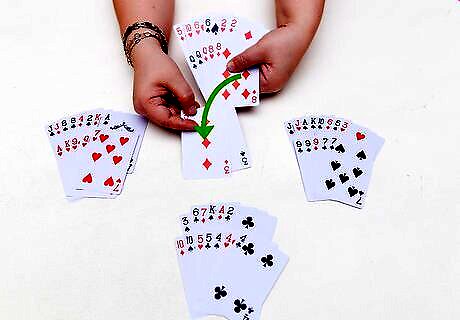
Play the three of diamonds in a pair or triple. If the player with the three of diamonds has another three in their hand, or two threes, they might consider playing the card in a double or triple. The advantage to this is that it forces the remaining players to also play a double or triple, potentially damaging their ability to get cards out of their hand. When playing a pair of cards, they must be of equal rank (ex. two nines or two jacks). Triples work in the same way. Higher suits will determine rank among equal pairs (ex. a nine of spades and of diamonds beats a nine of hearts and of clubs, because the spade is higher).

Play the three of diamonds in a group of five. For groups of five cards, there are five different ways to play them, many of the combinations similar to ones in poker. Naturally, five card groups are considered the most valuable because they are the most difficult to match and outrank. The groups are listed here in rank from lowest to highest: You can play a straight, which is five cards of successive rank using any suits (ex. six of hearts, seven of diamonds, eight of hearts, nine of clubs, and ten of spades). When ranks are identical, the suit of the highest ranked card determines supremacy. Four of a kinds are also possible, and you include any other card to make a combination of five. The four must be of the same rank (ex. all 4 sevens, and a three of spades). Choosing between two four of a kinds, the rank of the four cards decides supremacy. You can play a flush, which is a five card combination of any cards of the same suit (ex. nine of hearts, seven of hearts, six of hearts, ten of hearts, and three of hearts). Higher suits beat lower suits, irrespective of the ranks. Between identical suits, highest card determines supremacy. The next five card combination is a full house, which is essentially a pair and a triple. Three cards of one rank and two of another (ex. 3 fours and 2 sevens, of any suit). Deciding between two full houses, supremacy goes to the one whose triple is of a higher rank. Straight flushes are also possible as five successive cards of the same suit (with twos in this case ranking below threes, with aces able to be high or low)--an example would be an eight of spades, a nine of spades, a ten of spades, a jack of spades, and a queen of spades. Between equal ranked flushes, suit determines which is higher.
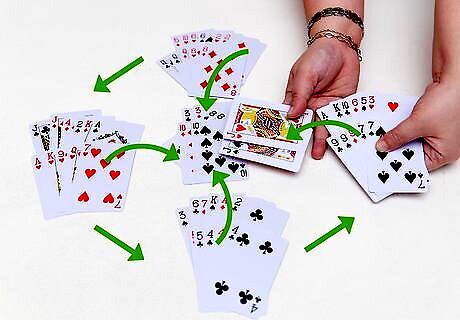
Continue play until everybody passes. The rules of big two require you to place increasingly higher-ranked cards, and always of whatever number combination the round began with. For example, if the first player (with the three of diamonds) plays it in a triple each successive player must play a triple of higher rank. Note, you are never obligated to play cards. If you believe it’s advantageous to hold on to your cards, you can pass at will. A five card group can be surpassed by a five card group of another, stronger type. They are listed in ascending order above (ex. a straight flush can beat any five card combination). When you are unable to play a higher card or combination of cards, you must pass. Once everyone save one player has passed, a new round will begin.
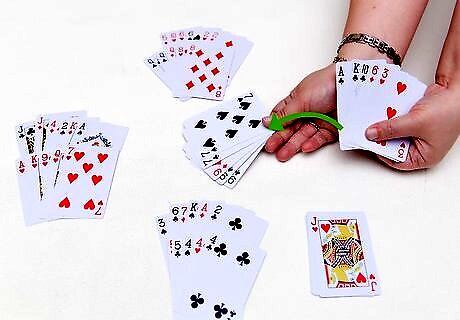
Begin a new round. To start again, take the previous round’s pile of cards and set them aside. The player who did not pass (who played highest) will play first by playing any single card or combination of cards. As with previous rounds, succeeding players may only play higher rank card combinations of the same number (or singles if a single card). The game will continue in this way until one person has played their last card. Once a player has emptied their hand of cards, they are automatically determined the winner.
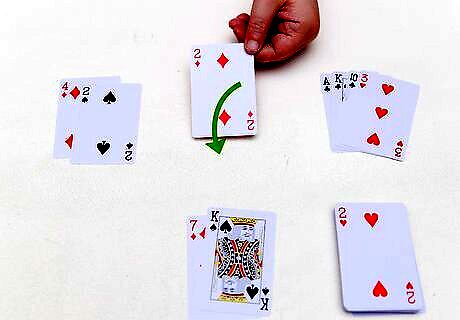
Score the remaining players. Traditionally, big two will include scoring to determine who is second, third, and last. This takes the form of penalty points counted up, determined by the number of cards left in hand. The player with the lowest number of the points will be second, the next lowest, third; and the player with most will be last. For those with nine cards or less in their hand, they will count one point per card. For those with ten, eleven, or twelve cards in their hard, they will count two points per card. For those with all cards still in their hand, their score will automatically be 39 (3 points per card).




















Comments
0 comment